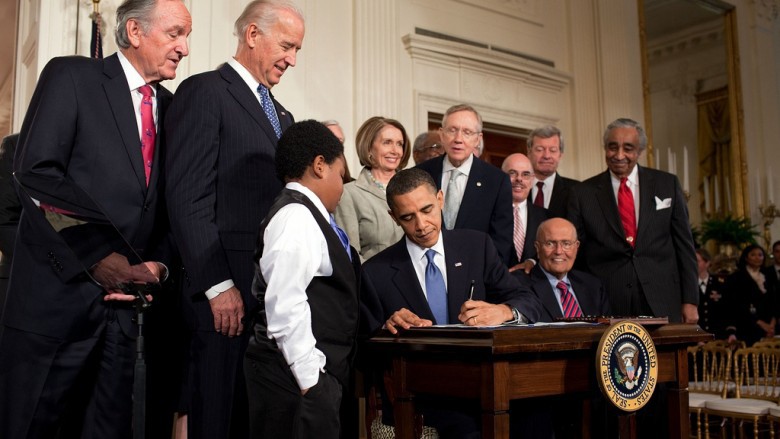Rising health costs pose long-term financial threat to families, study says
By Stephen Beale | January 18, 2016, 15:22 EST
 President Barack Obama signed the Patient Protection and Affordable Care Act in 2010, surrounded by Democrats. Not a single Republican in Congress voted for the measure. (Photo courtesy of Wikipedia.org)
President Barack Obama signed the Patient Protection and Affordable Care Act in 2010, surrounded by Democrats. Not a single Republican in Congress voted for the measure. (Photo courtesy of Wikipedia.org) BOSTON – Spiraling health care costs pose a grave fiscal threat to families, threatening to eat up as much as 45 percent of household incomes and crowd out other basic needs within two decades, according to a recent study.
“You’re looking at an unprecedented fiscal crisis for American families,” said Matt Blackbourn, the author of the study from the Pioneer Institute in Boston.
His report examines three possible scenarios for what could happen to the typical U.S. family – defined as having a median household income of $53,657 in 2014 – should the increase continue unabated. In one scenario, that family would see health-insurance premiums rise by 4 percent a year, along with the same rate of increase for out-of-pocket costs. By 2035, those expenses would consume nearly a quarter of the family’s budget – up from 16 percent in 2014.
That’s the best case scenario.
The worst case envisions premiums skyrocketing at double the annual rate used in the best-case projection and out of pocket costs going up by 6 percent instead of 4 percent. The typical American family would then be forking over about 45 percent of its income to health care expenses, limiting its ability to pay for other needs such as housing, food and fuel, according to Blackbourn, a researcher at the free-market oriented think tank.
Right in the middle is the family that would see roughly a third of its income go to health care costs.
“The principal takeaway from these findings is that, even in the most optimistic projections of health-care cost inflation, U.S. families will be paying an inordinate and unsustainable portion of their annual earnings on health-care costs in the future,” Blackbourne says in his report.
The Patient Protection and Affordable Care Act, President Barack Obama’s signature reform bill better known as Obamacare, has failed to rein in a steady decade-long trend of rising care costs, Blackbourn says. But it hasn’t exacerbated the problem either, he added.
Instead, what is driving prices ever higher is a basic market failure in which information on prices is not readily available to consumers and in which there is not much consistency in pricing among various hospitals and other health-care providers, according to Blackbourn. He contrasts this market dysfunction with a market where competition is driven by consumer choice based on transparency and availability of prices.
“Because there isn’t that same incentive to keep prices low, because the market pressures you’re seeing, these costs get increasingly larger ever single year,” Blackbourn said in the interview.
One of his key recommendations is for government agencies to more closely monitor costs, focusing on the impact increases have on those who bear more of the burden: average middle-class families. In Massachusetts, this recommendation is aimed at state agencies like the Health Policy Commission and the Center for Health Information and Analysis, both of which were created by a 2012 law that aims to combat soaring costs.
Spokesmen for both agencies declined to comment on the specific findings of the Pioneer study.
“Unfortunately due to timing and such, we won’t be able to fully analyze and comment on the report,” said Matthew Kitsos, the commission spokesman. He said the agency would release its own report on health-care costs at a meeting Wednesday.
When asked what his agency was already doing to address the issue of rising costs, Andrew Jackmauh, the Health Information center’s spokesman, said that it compiles reams of data on a vast range of figures – everything from provider and payer costs to hospital performance. Examples of these are its annual report on the Performance of the Massachusetts Health Care System, available here, and a report on the 2015 Massachusetts Health Insurance Survey, available here., which includes information about various medical expenses that families face.
The center’s employer and insurance surveys provide useful data for measuring health care affordability, such as the proportion of employers that offer high-deductible insurance plans, what employers contribute toward the cost of coverage and how much people spend out of their own pockets on health care, Blackbourn says in his report. “But, the budget picture for households is still limited,” he adds.
The report also looks at private employers, who have sought to tamp down costs by sharing them with employees. Such cost-sharing has a proven ability to lower expenses, but it also shifts more of the burden onto workers, according to Blackbourn. He also noted rapid enrollment growth in high-deductible health plans, which make consumers pay more of the costs.
Cost-sharing could lead to unintended consequences, prompting consumers to skip “necessary medical procedures and consultations” to save money, Blackborn says in the report. Making it work as an effective brake on price escalation also presumes that consumers have access to accurate information on prices.
High-deductible insurance works best when paired with tax-advantaged health savings, according to Sally Pipes, the head of the Pacific Research Institute in San Francisco. She advocates for increasing the limits that people can put aside tax-free from their incomes to cover out-of-pocket costs, noting that studies have shown that they help reduce spending without negatively affecting health outcomes.
Pipes also recommends lawmakers erase the financial disadvantage faced by consumers who buy their own health coverage with after-tax income instead of obtaining it from employers by creating a tax credit. This approach, she says in her book, “The Way Out of Obamacare,” published earlier this month, would also “do away with Obamacare’s huge subsidy-calculating machinery – such as its privacy-threatening data hub, legions of IRS workers and hugely complicated tax forms.”
Blackbourn calls on government regulators to allow the formation of alternative health clinics where walk-in patients could receive cheaper services.
“Expansion of this clinical model could generate significant cost savings through reducing unnecessary emergency department visits, increasing access to preventive services such as immunizations, and providing low-cost primary care for populations with limited coverage,” he says in his study.
Blackbourn admits that these seemingly modest recommendations aren’t a blueprint for fixing what ails the country’s health care system. Instead, he says these are merely “steps in the right direction.”
“I think they’ll have an impact, but they’re not going to solve the issue,” he told the New Boston Post.
Only fundamental reform in the health care system, Blackbourn says, can truly halt escalating costs. Until then, his report suggests that the least government authorities can do is a better job of monitoring the problem.











